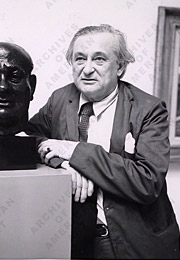


Bronze
53.7 x 44.5 x 23 cm (21 1/8 x 17 1/2 x 9 1/16 in.)
L.1988.62.66
Signed, engraved and stamped with foundry mark, on the base: J. Lipchitz 5/7 C. Valsuani cire perdue
Marcel Kapferer (ca. 1872–); seized by Einsatzstab Reichsleiter Rosenberg in Paris and held at he Jeu de Paume, intake date 24 Feb. 1944; restituted to Kapferer, 12 Oct. 1945. [Galerie Zak, Paris]; sold to Henry Pearlman, Mar. 1959; Henry and Rose Pearlman Foundation, 1986.
Lipchitz left his native Lithuania to study art in Paris in 1909. There, he adopted the medium of sculpture, often influenced by the stylized forms of ancient Scythian reliefs he had seen in the Hermitage Museum in St. Petersburg. Acrobat on Horseback celebrates the horse, a significant theme for the Scythian nomads of the steppes. Even more influential for Lipchitz, however, were recent French art and the painter Georges Seurat, especially his last painting, Circus. Seurat’s reductionist, geometric painting style thus inspired an elegant three-dimensional object.

Jacques Lipchitz (1891-1973)
Lipchitz is one of the major luminaries of 20th-century sculpture. Over the course of seven decades, he developed an oeuvre that spans many currents and materials, and his work is particularly notable for its ongoing inventiveness. Lipchitz’s sculpture ranges from figurative to highly abstract, and from Cubism to an expressionistic and often allegorical style.
Born to a Jewish family in Druskieniki, Lithuania, Lipchitz developed an early ambition to become an artist. His father, a building contractor, did not approve, but in 1909, with his mother’s encouragement, Jacques was able to move to Paris to study. Lipchitz received academic training at the École des Beaux-Arts and Académie Julian before settling in Montparnasse, which was a hotbed of the avant-garde. He became close friends with such neighbors as Pablo Picasso, Chaïm Soutine, and Amedeo Modigliani. Lipchitz looked toward a wide array of non-European cultures for inspiration and was especially inspired by African art. His work in geometric and abstract styles gained him a reputation as the major figure of Cubist sculpture.
After several prosperous decades in France, Lipchitz fled to New York in 1942 to escape the Nazi occupation. Arriving with only the few possessions he carried, the artist soon developed a robust new body of work and was hailed as one of the leading European expatriate artists. Lipchitz continued to work in the abstract allegorical vein that he had begun in the 1930s, depicting the struggles of humankind against oppression and fascism, rendered through mythological figures such as Prometheus and Theseus. Although he suffered a major setback when his studio was destroyed by fire in 1952, an outpouring of support from the Museum of Modern Art and other donors (including Henry Pearlman) allowed him to build a major new studio on the Hudson River. Lipchitz continued his prolific and diverse output until the end of his life, including work on numerous commissions for public sculptures in the U.S. and abroad.